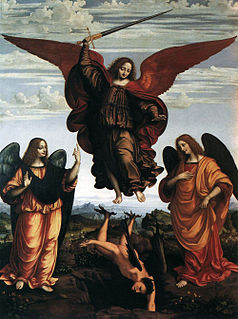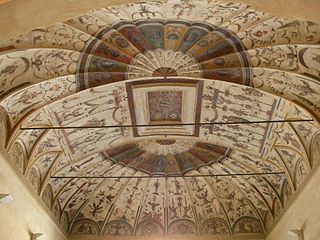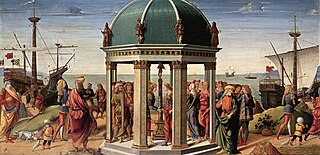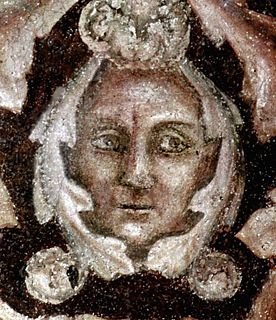
Pietro da Cortona was an Italian Baroque painter and architect. Along with his contemporaries and rivals Gian Lorenzo Bernini and Francesco Borromini, he was one of the key figures in the emergence of Roman Baroque architecture. He was also an important designer of interior decorations.

Faenza is an Italian city and comune, in the province of Ravenna, Emilia-Romagna, situated 50 kilometres southeast of Bologna.

Marco d'Oggiono was an Italian Renaissance painter and a chief pupil of Leonardo da Vinci, many of whose works he copied.
Felice Giani was an Italian painter of the Neoclassic style. His grand manner subjects often included Greco-Roman allusions or themes.
Vittorio Bigari was an Italian painter of the late-Baroque period.

Girolamo da Treviso, also known as Girolamo di Tommaso da Treviso the Younger and Girolamo Trevigi, was an Italian Renaissance painter in Henry VIII's court in England.

Marco Marchetti was an Italian painter of the late-Renaissance or Mannerist period. Born in Faenza, he is also known as Marco da Faenza. He painted an Adoration by the shepherds (1567) originally in the church of the confraternity of Santa Maria dell'Angelo, but now in the pinacoteca of Faenza. He also painted along with Giorgio Vasari a series of frescoes in the Palazzo Vecchio representing the Life of Hercules. He painted an altarpiece representing the Martyrdom of St. Catherine of Alexandria (1580) in the church of Sant'Antonio in Faenza.

Jacopo Bertucci was an Italian painter of the Renaissance period. He is also known as Jacopone da Faenza. He was born in Faenza, and worked under Raphael in Rome. One of his pupils was Taddeo Zuccari. He was active c. 1530 and painted in the manner of Raphael. He painted for the church of San Vitale at Ravenna. He died at the age of 20.

Biagio d’Antonio Tucci was an Italian Renaissance painter whose style was influenced by Filippo Lippi, Andrea Verrocchio and Domenico Ghirlandaio.

Francesco da Cotignola, also called Zaganelli, was an Italian painter of the Renaissance period, active mainly in Parma and Ravenna.
Giulio Tonduzzi was an Italian painter of the Renaissance period.
Raffaello Vanni was an Italian painter of the Baroque.
Giovanni Battista della Marca (1532–1587) was an Italian painter of the Renaissance period.

Pomponio Allegri was an Italian painter, the son of Correggio.

Michele Pace del Campidoglio (1625-1669) was an Italian painter of still-life depicting fruit and flowers.

Giovanni Battista da Faenza, called Bertucci, who painted in the style of Perugino and Pinturicchio, flourished in the early part of the 16th century at Faenza. In the Pinacoteca of that city there are various works ascribed to him, of which the most remarkable is a Majesty, signed by him and bearing the date 1506. Crowe and Cavalcaselle also claim for Bertucci an Adoration of the Magi in the Berlin Gallery, there ascribed to Pinturicchio, and a Glorification of the Virgin in the National Gallery, given in the catalogue to Lo Spagna, who was a pupil of Perugino.
Ottaviano da Faenza, an Italian painter of the 14th century, who was instructed by Giotto, spent the greater part of his life at Faenza, where he died. There are several paintings attributed to him to be found in the neighbourhood of Faenza, and at Bologna.
Sigismondo Foschi, also called Sigismondo da Faenza was and Italian painter of the Renaissance period, born and active in Faenza. He was likely a pupil of Giovanni Antonio Sogliani. As a young man, in 1520, he assisted his father in completing an altarpiece in a chapel in San Francesco in Faenza. Sigismondo’s father, Antonio, was a gold and silversmith. Sigismondo painted an Assumption of the Virgin (1522) for the church of Santa Maria della Terra at Solarolo. He painted a Madonna and child with saints (1527) for the church of San Bartolomeo in Faenza. Other sundry works are assigned to the painter without definitive attribution. An altarpiece of Madonna and child with Saints Paul, John the Baptist, Benedict (?), Sebastian, Catherine and Apollonia, originally from the church of Santa Maria ad Nives, is found in the Pinacoteca of Faenza. Documents establish that he died by 1536.

Antonio Berti was an Italian painter, mainly portraits, landscapes, and romantic scenes.
Antonio da Faenza was an Italian painter and architect active in Emilia-Romagna and Marche, active in a Renaissance style. The documentation on Antonio da Faenza is confused because, different authors have referred to him by various names including:
The public domain consists of all the creative works to which no exclusive intellectual property rights apply. Those rights may have expired, been forfeited, expressly waived, or may be inapplicable.

Michael Bryan was an English art historian, art dealer and connoisseur. He was involved in the purchase and resale of the great French Orleans Collection of art, selling it on to a British syndicate, and owned a fashionable art gallery in Savile Row, London. His book, Biographical and Critical Dictionary of Painters and Engravers, first published in 1813-16, was a standard reference work throughout the 19th century, and was last republished in 1920; however it is now badly outdated.

















